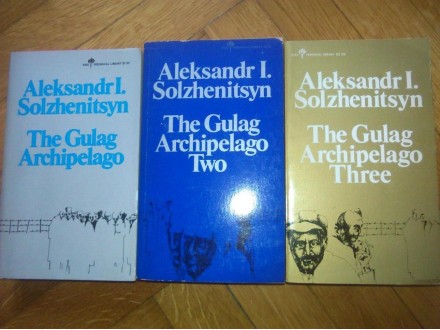Arhipelag GULAG I-III- Solzenjicin - 1973- PRVO IZDANJE
| Cena: |
| Želi ovaj predmet: | 6 |
| Stanje: | Polovan sa vidljivim znacima korišćenja |
| Garancija: | Ne |
| Isporuka: | Pošta Post Express Lično preuzimanje |
| Plaćanje: | Tekući račun (pre slanja) Lično |
| Grad: |
Beograd-Vračar, Beograd-Vračar |
ISBN: Ostalo
Tematika: Istorija
Godina izdanja: Posle 1950.
Kulturno dobro: Predmet koji prodajem nije kulturno dobro ili ovlašćena institucija odbija pravo preče kupovine
Jezik: Ruski
Autor: Strani
Aleksandr I. Solzhenitsyn - The Gulag Archipelago I -III
An Experiment in Literary Investigation
Harper& Row, New York, 1973, 1973, 1978.
Mek povez, 660+712+560 strana.
PRVO IZDANJE!
First edition of Solzhenitsyn`s `The Gulag Archipelago`.
Arhipelag Gulag...
The Gulag Archipelago: An Experiment in Literary Investigation (Russian: Архипелаг ГУЛАГ, romanized: Arkhipelag GULAG)Note 1 is a three-volume non fictional series written between 1958 and 1968 by the Russian writer and Soviet dissident Aleksandr Solzhenitsyn. It was first published in 1973, and it was translated into English and French the following year. It describes life in what is often known as the Gulag, the Soviet forced labour camp system, through a narrative which was constructed from various sources including reports, interviews, statements, diaries, legal documents, and Solzhenitsyn`s own experience as a Gulag prisoner.
Following its publication, the book was initially circulated in samizdat underground publication in the Soviet Union until its appearance in the literary journal Novy Mir in 1989, in which a third of the work was published in three issues.[1] Since the dissolution of the Soviet Union, The Gulag Archipelago has been officially published in Russia.
Structure
As structured in most printed editions, the text comprises seven sections divided into three volumes: parts 1 to 2, parts 3 to 4, and parts 5 to 7. At one level, the Gulag Archipelago traces the history of the system of forced labor camps that existed in the Soviet Union from 1918 to 1956. Solzhenitsyn begins with Vladimir Lenin`s original decrees which were made shortly after the October Revolution; they established the legal and practical framework for a series of camps where political prisoners and ordinary criminals would be sentenced to forced labor.Note 2
The book then describes and discusses the waves of purges and the assembling of show trials in the context of the development of the greater Gulag system; Solzhenitsyn gives particular attention to its purposive legal and bureaucratic development. The narrative ends in 1956 at the time of Nikita Khrushchev`s Secret Speech (`On the Personality Cult and its Consequences`). Khrushchev gave the speech at the 20th Congress of the Communist Party of the Soviet Union, denouncing Joseph Stalin`s personality cult, his autocratic power, and the surveillance that pervaded the Stalin era.
Although Khrushchev`s speech was not published in the Soviet Union for a long time, it was a break with the most atrocious practices of the Gulag system. Despite the efforts by Solzhenitsyn and others to confront the legacy of the Gulag, the realities of the camps remained a taboo subject until the 1980s. Solzhenitsyn was also aware that although many practices had been stopped, the basic structure of the system had survived and it could be revived and expanded by future leaders. While Khrushchev, the Communist Party, and the Soviet Union`s supporters in the West viewed the Gulag as a deviation of Stalin, Solzhenitsyn and many among the opposition tended to view it as a systemic fault of Soviet political culture, and an inevitable outcome of the Bolshevik political project.[citation needed]
Parallel to this historical and legal narrative, Solzhenitsyn follows the typical course of a zek, a slang term for an inmate derived from the widely used abbreviation z/k for zakliuchennyi (`prisoner`), through the Gulag, starting with arrest, show trial, and initial internment, continuing with the transport to the Gulag, the treatment of prisoners and their general living conditions, slave labor gangs and the technical prison camp system, camp rebellions and strikes, such as the Kengir uprising, the practice of internal exile following the completion of the original prison sentence, and the ultimate but not guaranteed release of the prisoner. Along the way, Solzhenitsyn`s examination details the trivial and commonplace events of an average prisoner`s life, as well as specific and noteworthy events during the history of the Gulag system, including revolts and uprisings.
At Chapter 4, Solzhenitsyn writes: `Macbeth`s self-justifications were feeble – and his conscience devoured him. Yes, even Iago was a little lamb, too. The imagination and spiritual strength of Shakespeare`s evildoers stopped short at a dozen corpses. Because they had no ideology. Ideology – that is what gives evildoing its long-sought justification and gives the evildoer the necessary steadfastness and determination. That is the social theory which helps to make his acts seem good instead of bad in his own and others` eyes.... That was how the agents of the Inquisition fortified their wills: by invoking Christianity; the conquerors of foreign lands, by extolling the grandeur of their Motherland; the colonizers, by civilization; the Nazis, by race; and the Jacobins (early and late), by equality, brotherhood, and the happiness of future generations... Without evildoers there would have been no Archipelago.`[2]
There had been works about the Soviet prison/camp system before, and its existence had been known to the Western public since the 1930s. However, never before had the general reading public been brought face to face with the horrors of the Gulag in this way. The controversy surrounding this text, in particular, was largely due to the way Solzhenitsyn definitively and painstakingly laid the theoretical, legal, and practical origins of the Gulag system at Lenin`s feet, not Stalin`s. According to Solzhenitsyn`s testimony, Stalin merely amplified a concentration camp system that was already in place; this is significant, as many Western intellectuals viewed the Soviet concentration camp system as a Stalinist aberration.[3]
Publication
After the KGB had confiscated Solzhenitsyn`s materials in Moscow, during 1965–1967, the preparatory drafts of The Gulag Archipelago were turned into finished typescript, sometimes in hiding at his friends` homes in the Moscow region and elsewhere. While held at the KGB`s Lubyanka Prison in 1945, Solzhenitsyn had befriended Arnold Susi, a lawyer and former Estonian Minister of Education, who had been taken captive after the Soviet Union occupied Estonia in 1944. Solzhenitsyn entrusted Susi with the original typed and proofread manuscript of the finished work, after copies had been made of it both on paper and on microfilm.[4] Arnold Susi`s daughter, Heli Susi, subsequently kept the `master copy` hidden from the KGB in Estonia until the dissolution of the Soviet Union in 1991.[5][6]
In 1973, the KGB seized one of only three existing copies of the text still on Soviet soil. This was achieved after interrogating Elizaveta Voronyanskaya, one of Solzhenitsyn`s trusted typists[7] who knew where the typed copy was hidden. Within days of her release by the KGB she was found hanged in the stairwell of her apartment. She had apparently either hanged herself or been murdered, 3 August 1973.[8] Although he had earlier wanted it published in Russia first, after Solzhenitsyn learned of her death, he decided the next month, September, to allow its publication in Paris. The first edition of the work was published in Russian by the French publishing house Éditions du Seuil a few days after Christmas 1973.[9] They had received a go-ahead from Solzhenitsyn but had decided to release the work about ten days earlier than he had expected. News of the nature of the work immediately caused a stir, and translations into many other languages followed within the next few months, sometimes produced in a race against time. American Thomas P. Whitney produced the English version. The English and French translations of Volume I appeared in the spring and summer of 1974.[10]
Solzhenitsyn had wanted the manuscript to be published in Russia first, but knew this was impossible under conditions then extant. The work had a profound effect internationally. Not only did it provoke energetic debate in the West; a mere six weeks after the work had left Parisian presses Solzhenitsyn himself was forced into exile. Because possession of the manuscript incurred the risk of a long prison sentence for `anti-Soviet activities`, Solzhenitsyn never worked on the manuscript in complete form. Since he was under constant KGB surveillance, Solzhenitsyn worked on only parts of the manuscript at any one time, so as not to put the full book into jeopardy if he happened to be arrested.
For this reason, he secreted the various parts of the work throughout Moscow and the surrounding suburbs, in the care of trusted friends. Sometimes when he was purportedly visiting them on social calls he actually worked on the manuscript in their homes. During much of this time, Solzhenitsyn lived at the dacha of the world-famous cellist Mstislav Rostropovich, and due to the reputation and standing of the musician, despite the elevated scrutiny of the Soviet authorities, Solzhenitsyn was reasonably safe from KGB searches there. Solzhenitsyn did not think this series would be his defining work, as he considered it journalism and history rather than high literature.[citation needed]
With the possible exception of One Day in the Life of Ivan Denisovich, it is his best-known and most popular work, at least in the West. Finished in 1968, The Gulag Archipelago was microfilmed and smuggled out to Solzhenitsyn`s main legal representative, Fritz Heeb of Zürich, to await publication; a later paper copy, also smuggled out, was signed by Heinrich Böll at the foot of each page to prove against possible accusations of a falsified work. Solzhenitsyn was aware that there was a wealth of material and perspectives about Gulag to be continued in the future, but he considered the book finished for his part. The royalties and sales income for the book were transferred to the Solzhenitsyn Aid Fund for aid to former camp prisoners. His fund, (The Russian Social Fund), which had to work in secret in its native country, managed to transfer substantial amounts of money towards helping former gulag prisoners in the 1970s and 1980s.[11][12]
Reception and impact
Beginning in 2009, Russian schools issued the book as required reading.[13][14] Russian president Vladimir Putin called the book `much-needed`,[13] while the Russian Ministry of Education said that the book showed `vital historical and cultural heritage on the course of 20th-century domestic history.`[15] Arseny Roginsky, then head of the human-rights organization Memorial, welcomed Putin`s backing for the Solzhenitsyn textbook.[14]
Natalya Reshetovskaya described her ex-husband`s book as `folklore`, telling a newspaper in 1974 that she felt the book was `not in fact the life of the country and not even the life of the camps but the folklore of the camps.`[16] In her 1974 memoir, Reshetovskaya wrote that Solzhenitsyn did not consider the novel to be `historical research, or scientific research`, and stated that the significance of the novel had been `overestimated and wrongly appraised.`[17] Reshetovskaya created an abridged version for Russian high-school students,[13] including her probing introduction about the unique nature of Solzhenitsyn`s `experiment in literary investigation.`[18][19] Her books were published by the Novosti Press, which was run by the KGB. Her editor there was Konstantin Semyonov, and he became her third husband.[20]
Academic
Historian and archival researcher Stephen G. Wheatcroft described the book as `a fine literary masterpiece, a sharp political indictment against the Soviet regime, and has had tremendous importance in raising the issue of Soviet repression in the Russian consciousness.` Wheatcroft wrote that the book was essentially a `literary and political work`, and `never claimed to place the camps in a historical or social-scientific quantitative perspective` but that in the case of qualitative estimates, Solzhenitsyn gave his inaccurately high estimate as he wanted to challenge the Soviet authorities to show that `the scale of the camps was less than this.`[21]Note 3
UCLA historian J. Arch Getty wrote of Solzhenitsyn`s methodology that `such documentation is methodologically unacceptable in other fields of history` and that `the work is of limited value to the serious student of the 1930s for it provides no important new information or original analytical framework.[22][23] Gabor Rittersporn shared Getty`s criticism, saying that `he is inclined to give priority to vague reminiscences and hearsay ... [and] inevitably [leads] towards selective bias`, adding that `one might dwell at length on the inaccuracies discernible in Solzhenitsyn’s work`.[24] Vadim Rogovin writes of the eyewitness accounts that Solzhenitsyn had read, saying he `took plenty of license in outlining their contents and interpreting them`.[25]
In an interview with the German weekly newspaper Die Zeit, British historian Orlando Figes stated that many Gulag inmates he interviewed for his research identified so strongly with the book`s contents that they became unable to distinguish between their own experiences and what they read: `The Gulag Archipelago spoke for a whole nation and was the voice of all those who suffered.`[26] Soviet dissident and historian Roy Medvedev referred to the book as `extremely contradictory`.[27] In a review for the book, Medvedev described it as without parallel for its impact, saying: `I believe there are few who will get up from their desks after reading this book the same as when they opened its first page. In this regard I have nothing with which to compare Solzhenitsyn`s book either in Russian or world literature.` In the same review, he also writes that `This book is full of thoughts and observations, some profound and true, others perhaps not always true but born in the monstrous sufferings of tens of millions of persons.`[28][29]
Popular press
Novelist Doris Lessing said that the book `brought down an empire`,[30] while author Michael Scammell described the book as a gesture that `amounted to a head-on challenge to the Soviet state, calling its very legitimacy into question and demanding revolutionary change.`[31] About its impact, philosopher Isaiah Berlin wrote: `Until the Gulag, the Communists and their allies had persuaded their followers that denunciations of the regime were largely bourgeois propaganda.`[30] United States diplomat George F. Kennan said that the book was `the most powerful single indictment of a political regime ever to be levied in modern times.`[32]
Author Tom Butler-Bowdon has described the book as a `Solzhenitsyn`s monument to the millions tortured and murdered in Soviet Russia between the Bolshevik Revolution and the 1950s.`[30] An edition of The Book Show said that the book helped expose the brutality of the Soviet system.[33] Psychologist Jordan Peterson, who wrote the foreword of an abridged fiftieth anniversary edition released on 1 November 2018,[34] described The Gulag Archipelago as the most important book of the twentieth century.[35]
Parallels have been drawn between the book and the treatment of Liao Yiwu, a dissident who is dubbed `the Chinese Solzhenitsyn` according to the Agence France-Presse.[36] Author David Aikman stated that Liao is the first Chinese dissident writer to `come up with a very detailed account of prison conditions including torture in China in the same way that [Soviet dissident Aleksandr] Solzhenitsyn did in The Gulag Archipelago.`[37] In 2019, journalist Mustafa Akyol drew a parallel between the book and Xinjiang re-education camps.[38]
Television documentary
In December 2009, the Russian channel Rossiya K showed the French television documentary L`Histoire Secrète de l`Archipel du Goulag[39] made by Jean Crépu and Nicolas Miletitch,[40] and translated it into Russian under the title Taynaya Istoriya `Arkhipelaga GULAG` (Secret History: The Gulag Archipelago). The documentary covers events related to the writing and publication of The Gulag Archipelago.[39][41][42]
Predmet: 75452945









